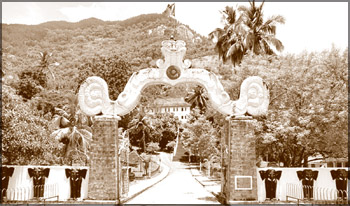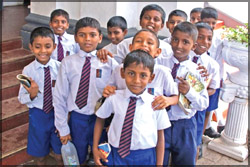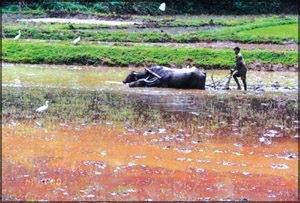|

Developing religious sites at Matale
The Aluvihara Temple and Muttu Amman Kovil of Matale will be
developed and renovated under a special project
|

The entrance to Aluvihara Temple |
of the Urban Development and Sacred Area Development Ministry.
The programme will be carried out by the Physical Planning Department
under the sacred area development programme.
A pilgrims' rest was a long-felt need in the area with both local and
foreign tourists undergoing many hardships due to the lack of one in
this sacred and historic area. This need was fulfilled when a foundation
stone was recently laid for a pilgrims' rest at the Aluvihara Temple.
It's expected to be completed at a cost of Rs. 20 million under the
guidance of the National Physical Planning Department. It would provide
accomodation to a large number of tourists to the area.
There are also plans to construct a pilgrims' rest for the historic
Muttu Amman Kovil. This will be carried out with the objective of
providing equal facilities and services to people belonging to many
faiths and religions.
Many other development projects are also expected to be inaugurated
soon to develop Matale.
New educational zone in Batticaloa
A new educational zone was opened in the Batticaloa district recently
by the Education Ministry. The new education office, named Batticaloa
Central Educational Zone, is the fourth educational zone in the
district, the 13th in the Eastern Province and the 94th in the country.
Activities relating to education in the areas of Eravur, Kattankudy
and Valaichenai are expected to become easier with the opening of this
zone. Problems of schoolchildren, teachers and principals would be
solved in a smoother manner.
This will also help share the resources provided by the Ministry of
Education, Asian Development Bank, World Bank, UNICEF and
non-governmental organisations, equally among schools.
Import of uniform material to be limited
Most of you may be getting the free school uniform material provided
by the government at the start of a new school year. Did you know that the government imports most of this
clothing material from abroad, at great cost to the country?
school year. Did you know that the government imports most of this
clothing material from abroad, at great cost to the country?
The Government has decided to limit the import of textile materials
for these uniforms from next year. The plans are to manufacture 55 per
cent of the textile requirement locally, and import only the balance 45
per cent. Over 11 billion metres of cloth is estimated to be required
next year for distribution among schoolchildren island-wide.
The future plan is to manufacture the entire requirement of uniform
material locally by encouraging local handloom industrialists with
incentives and subsidies. Apart from saving foreign exchange, it'll
provide employment opportunities too. Not only that, it'll also
encourage students to appreciate and admire locally-manufactured
material and products.
All students including those studying at pirivenas are provided with
free uniform material. Over Rs. 1,600 million is spent by the government
annually on these uniforms.
War to boost food production
Still on the subject of local products, the government plans to
launch a 'food production war' to promote local food production through
a three-year project. The assistance of the Agricultural Development and
Agrarian Services Development Ministry will be sought in this regard.
Services Development Ministry will be sought in this regard.
This national programme titled 'Let's Grow - Rebuild the Country'
will try to save the massive amounts of money spent on importing foreign
foods to the country.
Sri Lanka spends over Rs. 100 billion annually to import 32 per cent
of its food requirements. Apart from this, Rs. 49 billion was spent last
year to import milk products, fish, fruits, wheat flour and other food
products.
The country's socio-economic and cultural foundation was based on
agriculture from ancient times. However, the local food production
process has now suffered a setback.
Although 32 per cent of the total Sri Lankan population of 20 million
are directly engaged in agriculture, and 70 per cent of rural folk are
engaged in agriculture-related professions, production hasn't reached
the required levels.
To rectify this situation, it has been decided to launch the food
production war according to a national plan with the participation of
all sections of the community and the co-operation and contribution of
all parties. The three-year programme hopes to cultivate 52,000 hectares
of unutilised lands during the Maha season next year.
Out of the 730,000 hectares of land suitable for paddy cultivation in
the country, nearly 13,000 hectares remains unused. Out of 120,000
hectares available for cultivation of subsidiary crops, 40,000 hectares
are unused.
|
